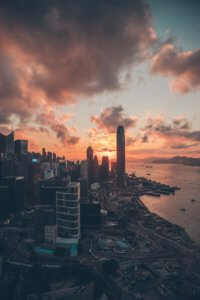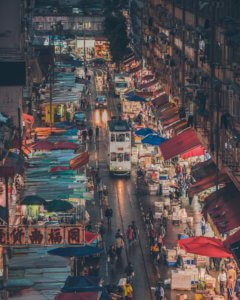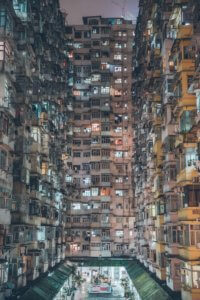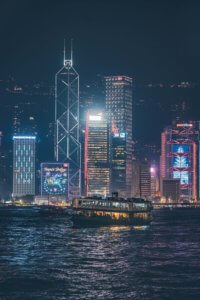“The simplest things are often the most significant. Take notice.”
Harimao Lee
Freelance Photographer / Instagrammer
Our Urban Explorer
Could you please introduce yourself to our guests?
I’m Harimao Lee, but my close friends call me Simon.
I am a freelance photographer from Hong Kong and I have only transitioned into the role as a full-time freelance photographer two years ago. The decision originated from my aspiration to make time for my commercial work, whilst continue shooting the things I enjoyed.
I generally focus on urban landscapes and street photography in Hong Kong, but in recent years, I have had the opportunity to do more travel photography for other brands.
What does the term ”Urban Explorer” mean to you? How do you think you fit into it?
To me, “Urban Explorer” is a person or a group of people that possess a fresh pair of eyes, with an attention to detail. They want to share with others their unique viewpoint of the city, in which one does not usually take notice of even when they pass by it in their everyday commute.
These urban explorers will meander across a metropolis, skidding in and out of every crack and cranny in search of beauty in these extraordinary places. Through the eyes of these urban explorers, it not only inspires people to take notice, but to truly discover the city’s splendors and gems.
When did you pick up your first camera?
The first camera I picked up was by complete coincidence. I was in secondary school when I was approached by one of the school staff to take photos for some school activities. I had no idea how to operate a camera back then, but it was that moment where photography sparked an interest in me. From then, I knew I enjoyed capturing moments, people, places and things. It was not until I graduated from high school that I bought my very first camera and developed photography as a hobby.
Your photography is captivating, especially your signature urban photography consisting of rooftop, aerial and street portraits. How did you get into this specific genre?
The journey to my current photography style is through a lot of trial & errors.
After picking up photography during secondary school, I practiced through taking photos of school events, and capturing images of the great outdoors – essentially, everything that interested me. My photography style and the subjects I photographed greatly differs from the beginning to what it is now. Through life experiences and inspirations, I naturally progressed into more landscape photography – from mountains and oceans to sunsets and sunrises, of which you can find more resemblances towards my current style. I can recall in my university years, I would wake up at 3am in the morning and hike up a mountain just to capture the sunrise to get that perfect golden “egg-yolk”.
My style kept on evolving, but the major turning point was when I started to use Instagram. I would join these unofficial “Instameets”, where meet-ups are organized by other photographers. We would go on photography excursions as a group to places that people won’t usually think to visit; some of these places include underground and rooftop. There is just something so mesmerizing about standing on top of a skyscraper and looking down at the entire city, admiring the beauty and magnitude of Hong Kong – that is what inspired me to get into urban landscape photography.
It is the people that I’ve met, and the experiences I went through that I’ve drawn inspiration from that is evident in my current photography style.

To Harimao Lee, “Urban Explorer” is a person or a group of people that possess a fresh pair of eyes, with an attention to detail. They want to share with others their unique viewpoint of the city, in which one does not usually take notice of even when they pass by it in their everyday commute.
What does a day in the life of Mr. Harimao Lee look like as a freelance photographer?
I am actually in the air quite often, flying from one place to another for business and for pleasure. However, when I am in Hong Kong, my schedule is quite routine. On a typical day, I would usually wake up and hit the gym. After that, I will go home to do some paper work and liaise with my clients for a few hours, before heading out to have lunch and to start my daily shooting.
I generally plan out what I want to shoot the day before, but I try not to limit myself to one certain location. I will usually pick an area and explore that area for a few hours to find inspirations. Just before the sun begins to set, I make it compulsory to go to specific locations that would allow me to shoot the sunset as it is a reoccurring theme in my photos.
Then by the end of the day, I would head to the closest Dai Pai Dong as it is one of my favorite joints to hit up for a nice casual meal with friends.
What do you like most about your job?
I really enjoy the flexibility that comes with working as a freelance photographer, and because of what I do on Instagram, I am able to create content of things that matter to me. With the flexibility of my job, I can also form my own schedule and have time to travel, and this is something I really love doing.
I would like to continue to travel around the world and experiencing the different riches in life. When I was working full-time, I could not enjoy these things so being able to do so now is the greatest luxury of all. I feel very lucky, and extremely grateful!
Passion in Photography
As a proud Hong Kong photographer, Hong Kong’s skyline and city views has largely been a reoccurring theme in your images. What do you want to show your audience about our city?
Hong Kong is my home and I love our city. Many of my Instagram followers are from different parts of the world, so there is so much I want to share with them, and hopefully inspire them to travel to Hong Kong.
First of all, I love to show them how densely populated Hong Kong really is. Not just the amount of people in this city, but the amount of buildings and skyscrapers within the city – it is quite shocking!

Hong Kong is one of the densest cities in the world, and through his photos, Harimao wants to show his followers how densely populated Hong Kong really is.
Secondly, I want to introduce to them interesting facts about our city and places that are not in the common guidebooks.
Lastly, I want to be able to communicate to my audience how multicultural Hong Kong really is. Essentially, our city is a melting pot of different cultures, which is what makes our city so rich and colorful.
Do you think that if you were in a different city, there would not be as much for you to shoot? Which other destinations inspire your photography?
In many ways, I do believe that because Hong Kong is an exceptional place where both eastern and western cultures are fused together in one locale, so there are so many unique cultures and subjects to shoot. In addition, Hong Kong’s geography is quite extraordinary. Within a day, you could be roaming around in the city to capture the dense urban landscape and could end up on a hike and photographing some of the most beautiful hills and valleys, so this distinctive feature makes the city any photographer’s dream to shoot.
To answer your second question, India is a destination that gave me great inspiration. I am in complete awe of the country’s landscape and culture, and would definitely like to visit again. In fact, I am actually planning to head to New Delhi sometime this year so I can admire the Taj Mahal in person.
You have over 200K followers on Instagram. When did you start your Instagram account? Any tips for our readers? Any notable photo editing tools?
I started my Instagram account in 2013 and have met so many incredible people & friends along the way. One of the tips I can offer to anyone who wants to start their own account is consistency – consistency when it comes to the style and theme of your account and consistency of posting every day at a time when your audience is most engaged on the platform. One other advice I can offer is that Instagram is a community, not a just platform for you to post a photo album; hence, interaction with other accounts is very important. It is about how you communicate with others on the platform so that they can be better acquainted with your work and vice versa.
Visitors are always camera-ready to capture special moments on their trip. As an expert photographer, can you tell us what factors you consider when taking the perfect photo? (Eg. Composition, lighting, setting of the camera, etc.)
To me, the most important thing is lighting; without good or proper lighting, the image completely loses its spirit. Each photographer has their own personal preference when it comes to lighting, but I enjoy taking pictures during the golden hour whether it is sunrise or sunset. Shooting during daytime or in the afternoon could pose more difficulty, as the natural sunlight is too strong and bright resulting in the photos coming out a bit overexposed, losing some of the detailing.
Before shooting, I plan out how my photography style can come through in my photos. As you see in most of my images, there is always a person in it so that it can show the magnitude of where I am shooting; this is a certain aesthetic I like to portray. Hence, this is another factor that should be taken into consideration for that “perfect shot”.
What is your default go-to camera when you shoot landscape portrait? What about evening skyline shots? (Aerial shot, Night portrait)
For every shoot, I take my essential full-frame camera and my three go-to lenses, which usually fulfills all sizes of images I want to shoot. Three of my go-to zoom lenses are the 11mm-24mm, 24mm-70mm, 70mm-200mm. I will also bring my drone to capture those wide aerial view shots.
The life of a photographer has its perks but also has its efforts – you have to wake up really early for those sunrise shots, you have to carry all these gadgets when traveling and hiking up a mountain. It is not an easy feat!
As an urban explorer that is always out and about, which is the best season/ month to take pictures in Hong Kong?
I prefer the summer months because during this time of year, the ocean breeze blows away the dust particles so the air is much cleaner. The clarity is much more noticeable in the photographs taken during the summer as compared to the winter months. In the winter, the air is more polluted, so it almost looks as if there is a film covering the image. Of course, the summer in Hong Kong is also much more humid so hiking up those mountains may not be particularly pleasant.
How do you want to inspire people, in terms of photography?
Through my photography, I hope to inspire people to seek beauty within the ordinary. The simplest things are often the most significant. Take notice, be meticulous. We often ignore the smallest details in life, but there are so much beauty in this world that is worthy of our attention. So if there is one thing that I can advise to all explorers, it is to do more & see more, it is simply that.
Travel Inspiration
So where does your inspiration for travel come from?
I tend to get my travel inspiration from various photo-driven platforms, namely Instagram, Pinterest, and recent popular Mainland Chinese platform XiaoHongShu (小紅書). Through these apps and online portals, I am able to scout out destinations around the world which fuels my travel inspiration and photography.
This may come as a surprise but I also use Google Maps to scout out real-time images of the place I wish to visit. I am someone who will type in a specific destination and then look at the street view to ensure that I am fully-prepared before going there to take photos. If I was living in the city, I could just go back to the same place the next day, but if I am visiting a far-away country, I only have one chance to get that perfect shot so I don’t want to miss out.
You travel around the world, taking some of the most breath-taking photos that give us serious wanderlust. Often times, many photographers chase the perfect shot as opposed to living and experiencing the moment. What are your thoughts on this?
In my opinion, I think both are quite important. If you admire the beauty of a place, you will naturally want to take a photo of it to keep it for memory’s sake. For me, when I travel to a new country I will mark down a few places that I want to photography but I will also make it a point to seek out other places for myself to experience that need not be documented in my photography.
Given that you can fit them into one bag, what are your must-have items when you go exploring in Hong Kong? Would be grateful if you could bring some of these items to the interview, including camera and a few pieces of photography equipment.
As said before, my travel essentials include my full-frame camera, three lenses, drone and some props for my photographs like fairy lights, and I have this foldable portable lamp that looks like a paper book that I take with me on my travels. I would carry these items either in a backpack if I’m traveling around the city or in a small suitcase to make it easier for me to haul around.
In 3 words, how would you describe Hong Kong?
Hectic, Energetic, Multicultural
Which locations in Hong Kong are the most Instagram-worthy for any traveler and urban explorer to visit?
There are so many places to visit, where do I start? To begin, I would recommend any visitor to go to Yick Cheong Building, one of Hong Kong’s most Instagrammable sites, known for its incredibly dense and stacked flats.

Also known as the ‘Monster Building’ for its conglomeration of five incredibly residential complexes in Quarry Bay, Yick Cheong Building is one of the most Instagram-worthy spots in the city.
Another location I would recommend is Chun Yeung Street in the North Point district. What’s so iconic about this area is that there is a tramline running along the middle of the street with bustling wet markets on either side, making for a truly unique backdrop for photos.
Another super Insta-famous location is Choi Hung Estate, known for its rainbow colored pastel buildings. The street markets on Temple Street in Yau Ma Tei is another magnificent sight, especially at night, for that perfect snapshot. The tents illuminating in the dark makes for a really nice contrast.
As much as urban explorers enjoy visiting must-see tourist attractions, they also enjoy being enriched by the city’s authentic local culture and taste. If you could pick one place or restaurant that embodies the essence of Hong Kong, where would it be?
It’s easy – the iconic Hong Kong skyline! It speaks volumes about our city and the best spot to see this view is right from the Tsim Sha Tsui Promenade looking towards the skyline in the Hong Kong island side.
